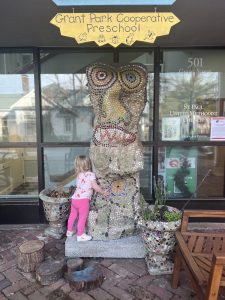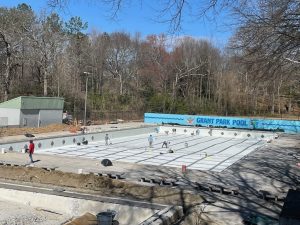By Alisa Chambers
The Grant Park Conservancy announces the expansion of its Canopy Care program. In conjunction with historic preservation, one of the main focuses of the Grant Park Conservancy over the past five years has been the removal of invasive plants and vines throughout the park’s woodlands. In early 2017, we contracted the pruning and consultation services of Fine Pruning, who helped us establish our canopy care program, including planting trees and caring for them through structural pruning and the management of invasive species. Our canopy care program is funded primarily by member support.
Constant maintenance and vigilance are required to keep those pesky invasive plants from coming back and smothering the park’s desirable native plants and tree species. We rely on volunteers to help us with invasive removal projects during our Project GRANT work days, but Grant Park is one of Atlanta’s five largest parks, and we needed more help than twice a month could cover. To meet this need, we are pleased to announce that we’ve contracted services from local invasive removal company, Woods Keeper.
Woods Keeper was established in 2020 by Michael Hudgins. During a time of transition in his life, Michael had been working different jobs in the service and entertainment industries and was looking for something new once he got married and was thinking of starting a family. He joined Americorps, and as a service member he was trained to spot and remove invasive species while building trails in parks. He really enjoyed this work and saw a need for it all over Atlanta, so he established Woods Keeper to consult and perform the meticulous work that invasive removal requires.
In 2022, Michael hired Brady Griggs, who works alongside him as they remove invasives by hand. This was one of the main reasons we hired Woods Keeper – their attention to detail and knowing the importance of getting an invasive by the root and disestablishing them completely from the woodland. They started with us in November 2022, and until February 2023 were focused on the wetland area of the park, north of the Milledge Fountain off of Cherokee Avenue.
The wetland area in Grant Park is special. It is one of the lowest points of elevation in the park, so much of the runoff from heavy rains ends up there. It’s very boggy after a rain, holding the water there until it can drain, and during dry times, you can spot many special native plants and trees. The main tree you’ll notice in the wetland are the bald cypresses and their “offspring,” cypress knees. Bald cypresses are mostly found in southern Georgia and the coastal plains, and are not easily spotted in metro Atlanta, so to find them in Grant Park is a treat. We want to do all we can to protect the bald cypresses, which is why we had Woods Keeper begin in this area.
Metro Atlanta is currently facing an invasive species crisis with the relentless Japanese chaff flower. They are prolific, and must be removed carefully by hand, placed in a contractor bag, sealed tightly, and thrown away. This invasive species was starting to take over in the wetland area, and addressing it quickly was key to stopping its spread. Woods Keeper removed several bags of chaff flower, along with Chinese privet, bush (amur) honeysuckle, English ivy, winter creeper, cherry laurel, and porcelain berry. In all, Woods Keeper has removed approximately 175 cubic yards of invasive and aggressive plant materials (to visualize this, a cubic yard is about as big as a washing machine, so they removed 175 washing machines full of invasive materials!). Michael says, “It’s been such a pleasure to work beneath the cypress and birch trees! We can’t wait to explore more of the park as we continue to remove and suppress invasive plants.”
Once these materials are removed, the wetland is more habitable for our desired natives, such as swamp iris, lizards’ tail, wood oats, goldenrod, and birch and cypress trees. Two other special plants to spot in this area are button bush and aster, both which are big pollinator supporters. You’ll also notice there are little piles of sticks in the wetland area. The downside of invasive removal is sometimes a loss of habitat for the little critters that live in the park, so it’s important to leave small piles of sticks and non-invasive materials behind for them to reestablish their habitat.
Now that they have removed the bulk of the invasive species in the wetland, Woods Keepers are moving on to the culvert area south of the playground, focusing on the usual suspects of privet, bush honeysuckle, cherry laurel, English ivy, and chaff flower. Look for the “native restoration in progress” signs and see what they’ve done to eradicate destructive invasive species in Grant Park’s woodlands.
Funding for the Conservancy to hire Woods Keeper comes primarily from member support. To support this and other Conservancy Canopy Care efforts, please become a member by visiting www.gpconservancy.org.







